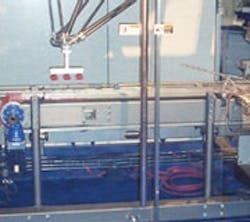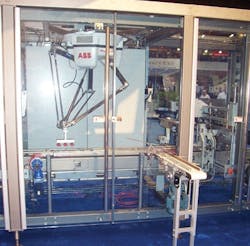Better, Faster Cookie Packaging? Sweet!
Smart machine builders know when they need some help from their friends.
Langen Packaging Group (www.langeninc.com) in Mississauga, Ontario, has been building and refining its LCR-500 top-loading robotic cells for about 10 years, and customizes its platform with various standardized modules for the different applications and products that its users want to quickly put into boxes. Basically, LCR-500's in-feed conveyor uses a linear servo pack, which sends trays of products to a robot that picks them up and inserts them into cartons. These boxes are formed and erected from blanks, and then hot-melt glued once the items are inside.
One of Langen's best customers not only wanted 10 new machines, related case packer, and in-between conveyors delivered on time to meet its own production schedules, but it also wanted Langen to make sure it could hit some very specific performance targets.
"We were committed to availability and performance of about 97% for 400 top-loaded and closed packages per minute, but we didn't have a full-scale line on our shop floor, and we couldn't test the equipment at the required and sustainable rates for extended periods of time," says Rafael Trzaskoma, Langen's project manager. "It's a big challenge to mimic actual production on a factory floor."
Langen Packaging's LCR-500 top-loading robotic cell uses production measuring and performance management software to identify in-feed adjustments needed in a cookie manufacturing application.
The first phase of the project involved 6-8 months of development, testing and debugging at Langen's shop, and several more weeks of setup, commissioning and validation at the user's facility. "We discovered a lot of issues with trying to run fresh-from-the-oven products faster and faster," Trzaskoma says. "We broke the process down into stages, and eventually adjusted the servos' programming to better control in-feed conveyor speed and added another conveyor stage to gain more velocity control and stability."
However, to make the right adjustments, Langen and its customer's engineers needed better production data than the per-shift numbers they were collecting. They spent two weeks collecting real-time production and downtime data, both manually and from the cell's HMIs, and then sought a way to analyze it all. "We found it was easier to get the baseline we needed with Shoplogix's software," Trzaskoma explains. "The software identified two products that had problems at the in-feed stage, and that we needed a mechanical adjustment and a software tweak, which produced much better results." The software also showed that the wrapper and guillotine cutter needed to be adjusted, he says, and that the width of its side belts had to hold a closer and more-consistent tolerance, or newly baked and temporarily mushy products could cause big problems.
Because of their optimization efforts during the first phase, Langen and its customer had a much easier time when the cookie maker had to adopt some changes to make its required availability and efficiency gains more sustainable for long-term operations, Trzaskoma reports. "We no longer have to wait for the end of shift to pinpoint a problem, and that's a big advantage," he says. "Now, we can map likely problems ahead of time."


